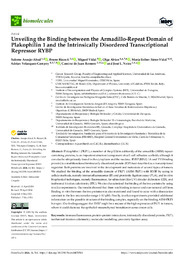Título :
Unveiling the Binding between the Armadillo-Repeat Domain of Plakophilin 1 and the Intrinsically Disordered Transcriptional Repressor RYBP |
Autor :
Araujo-Abad, Salomé
Rizzuti, Bruno
Vidal, Miguel
Abian, Olga
Fárez-Vidal, María Esther
Velazquez-Campoy, Adrian
de Juan Romero, Camino
Neira Faleiro, José Luis |
Editor :
MDPI |
Departamento:
Departamentos de la UMH::Agroquímica y Medio Ambiente |
Fecha de publicación:
2024 |
URI :
https://hdl.handle.net/11000/37788 |
Resumen :
Plakophilin 1 (PKP1), a member of the p120ctn subfamily of the armadillo (ARM)-repeat-containing proteins, is an important structural component of cell–cell adhesion scaffolds although it can also be ubiquitously found in the cytoplasm and the nucleus. RYBP (RING 1A and YY1 binding protein) is a multifunctional intrinsically disordered protein (IDP) best described as a transcriptional regulator. Both proteins are involved in the development and metastasis of several types of tumors. We studied the binding of the armadillo domain of PKP1 (ARM-PKP1) with RYBP by using in cellulo methods, namely immunofluorescence (IF) and proximity ligation assay (PLA), and in vitro biophysical techniques, namely fluorescence, far-ultraviolet (far-UV) circular dichroism (CD), and isothermal titration calorimetry (ITC). We also characterized the binding of the two proteins by using in silico experiments. Our results showed that there was binding in tumor and non-tumoral cell lines. Binding in vitro between the two proteins was also monitored and found to occur with a dissociation constant in the low micromolar range (~10 μM). Finally, in silico experiments provided additional information on the possible structure of the binding complex, especially on the binding ARM-PKP1 hot-spot. Our findings suggest that RYBP might be a rescuer of the high expression of PKP1 in tumors, where it could decrease the epithelial–mesenchymal transition in some cancer cells.
|
Palabras clave/Materias:
Immunofluorescence
Protein–protein interactions
Intrinsically disordered protein
PKP1
Isothermal titration calorimetry
Molecular modelling
Proximity ligation assay |
Área de conocimiento :
CDU: Ciencias puras y naturales |
Tipo de documento :
info:eu-repo/semantics/article |
Derechos de acceso:
info:eu-repo/semantics/openAccess
Attribution-NonCommercial-NoDerivatives 4.0 Internacional |
DOI :
https://doi.org/10.3390/biom14050561 |
Publicado en:
Biomolecules |
Aparece en las colecciones:
Artículos Agroquímica y Medio Ambiente
|
 La licencia se describe como: Atribución-NonComercial-NoDerivada 4.0 Internacional.
La licencia se describe como: Atribución-NonComercial-NoDerivada 4.0 Internacional.
.png)
